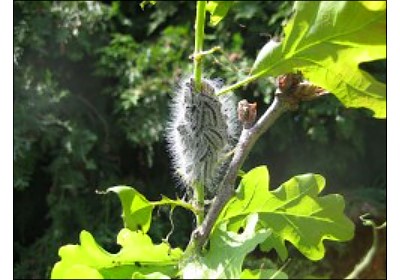
Oak Processionary Moths (OPM)
It is the season for OPM caterpillars, a pest that has sadly become established in Elmbridge and most of Surrey.
OPM caterpillars feed on oak leaves and can do quite serious damage to infested trees. It is believed it was introduced into the country in trees imported when the Olympic site was being developed, so it is non-native and, as yet, has no predators. This, and the fact that it nests in oaks which also host thousands of other valuable invertebrates and wildlife, mean that it is very difficult to control and it has spread throughout the South East since its introduction, despite efforts to contain it.
Elmbridge Borough Council has useful information about OPM on its website, as does the Forestry Commission, and both have ‘hotlines’ for reporting sightings (opm@elmbridge.gov.up and opm@forestrycommission.co.up.). The Council will try to destroy nests they know about (prioritising them where safety is a concern, eg. near a school).
The caterpillars are covered in long white hairs. These can break off if touched and can cause a nasty skin rash and also eye irritations. If you breathe them in they can cause coughs and throat irritations.
So if you, or your children, see a caterpillar:
- Do not touch it. Give it a wide berth.
- If you can identify the tree where they are nesting, report it to the Council using the dedicated OPM email, giving as much information about the location as you can, so it can be added to the database.
- If you suspect an allergic reaction to the hairs, check out the NHS website which has information on OPM and call 111.
From Elmbridge Borough Council's Countryside Officer, Hamish White:
The oak processionary moth was first found in London in 2006 and has been spreading ever since. OPM was identified in the Elmbridge Borough by the Forestry Commission (FC) funded surveys back in around 2011-2012 with a small number of sites identified in the north east section of the borough (East Molesey) but has continued to spread since then.
OPM has spread significantly during 2020 with the moth eggs appearing to survive the winter extremely well, this has resulted in a number of hots spots within the borough which have proved problematic in terms of current management protocols. This has been exacerbated by the current pandemic which has resulted in altered working practices by contractors slowing down the available response together with a shortage of PPE used by contractors to remove OPM nests.
We are currently in the middle of the OPM season (May to July is the greatest risk period) and OPM is now common-place across the whole of the borough of Elmbridge. The main hot spots we have centre around Weston Green and Ditton Common. The recent hot still weather has made caterpillars’ hairs more mobile and so a problem for residents and visitors alike, as they can cause skin rashes and less frequently eye and throat irritations and breathing difficulties in people and animals.
We have been assessing last year's sites and following up from reports by the public through our OPM email address opm@elmbridge.gov.uk. Notices are being placed on trees where nests are found low down to warn the public and high risk areas are being collated and mapped for nest removal, where appropriate. We carried out some spraying of caterpillars early on the season along the boundary between Claygate Common and the Foxwarren estate and if this proves successful we will consider it for other hot spots next year.
Nest removal by contractors will start on Ditton Common week beginning 25 June.
Further information can be found on the Council's webpages:
https://www.elmbridge.gov.uk/leisure-and-culture/oak-processionary-moth/
